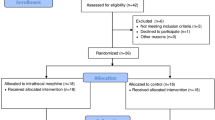Abstract
This study examined the effects of intrathecal analgesia (ITA) using an extracorporeal pump with a subcutaneous port system in cancer patients with bone metastasis. Among the patients who died of cancer with bone metastasis at the palliative care unit of our institution, 11 who received ITA were selected. Changes in pain, opioid doses, the palliative prognostic index (PPI), and Eastern Cooperative Oncology Group Performance Scale after ITA were assessed. Pain, opioid doses, and PPI decreased after ITA (P = 0.002, 0.002, and 0.017). ITA for cancer patients with increased PPI due to refractory cancer bone pain decreased pain, opioid doses, and PPI.
(100 words).



Similar content being viewed by others
Data availability
Raw data were generated at Saga-ken Medical Center Koseikan. Derived data supporting the findings of this study are available from the corresponding author IH on request.
References
Dong D, Zhao M, Zhang J, Huang M, Wang Y, Qi L, Wan CF, Yu X, Song T. Neurolytic splanchnic nerve block and pain relief, survival, and quality of life in unresectable pancreatic cancer: a randomized controlled trial. Anesthesiology. 2021;135:689–98.
Fujii-Lau LL, Bamlet WR, Eldrige JS, Chari ST, Gleeson FC, Abu Dayyeh BK, Clain JE, Pearson RK, Petersen BT, Rajan E, Topazian MD, Vege SS, Wang KK, Wiersema MJ, Levy MJ. Impact of celiac neurolysis on survival in patients with pancreatic cancer. Gastrointest Endosc. 2015;82:46–56.
Rathmell JP, Rickerson EM, Tulsky JA, Lillemoe KD. Reassessing the role for sympathetic neurolysis in patients with pancreatic cancer. Anesthesiology. 2021;135:573–5.
Fried LP, Tangen CM, Walston J, Newman AB, Hirsh C, Gottdiener J, Seeman T, Tracy R, Kop WJ, Burke G, McBurnie MA; Cardiovascular Health Study Collaborative Research Group. Frailty in older adults: evidence for a phenotype. J Cerontol A Bio Sci Med Sci. 2001. https://doi.org/10.1093/Gerona/56.3.m146.
Anderson F, Downing GM, Hill J, Casorso L, Lerch N. Palliative performance scale (PPS): a new tool. J Palliat Care. 1996;12:5–11.
Morita T, Tsunoda J, Inoue S, Chihara S. The palliative prognostic index: a scoring system for survival prediction of terminally ill cancer patients. Support Care Cancer. 1999;7:128–33.
De Iaco F, Mannaioni G, Serra S, Finco G, Sartori S, Gandolfo E, Sansone P, Marinangelii F. Equianalgesia, opioid switch and opioid association in different clinical settings: a narrative review. Eur Rev Med Pharmacol Sci. 2022;26:2000–17.
Takakuwa O, Oguri T, Maeno K, Murase H, Asano T, Ichikawa H, Kawaguchi Y, Uemura T, Ohkubo H, Takemura M, Niimi A. Long-term use of a once-a day fentanyl citrate transdermal patch in lung cancer patients. Oncol Lett. 2015;9:2105–8.
Williamson A, Hoggart B. Pain: a review of three commonly used pain rating scales. J Clin Nurs. 2005;14:798–804.
World Health Organization. Cancer pain relief. 2nd ed. Geneva: World Health Organization; 1996.
Mercadante S. Refractory cancer pain and intrathecal therapy: critical review of a systematic review. Pain Ther. 2023;12:645–54.
Sjöberg M, Nitescu P, Appelgren L, Curelaru I. Long-term intrathecal morphine and bupivacaine in patients with refractory cancer pain. Results from a morphine: bupivacaine dose regimen of 0.5: 4.75 mg/ml. Anesthesiology. 1994;80:284–97.
Nitescu P, Appelgren L, Hultman E, Linder LE, Sjögern M, Curelaru I. Long-term, open catheterization of the spinal subarachnoid space for continuous infusion of narcotic and bupivacaine in patients with “refractory” cancer pain. a technique of catheterization and its problems and complications. Clin J Pain. 1991;7:143–61.
Arcidiacono PG, Calori G, Carrara S, McNicol ED, Testoni PA. Celiac plexus block for pancreatic cancer pain in adults. Cochrane Database syst Rev. 2011. https://doi.org/10.1002/14651858.CD007519.pub2.
Yan BM, Myers RP. Neurolytic celiac plexus block for pain control in unresectable pancreatic cancer. Am J Gastroenterol. 2007;102:430–8.
Lillemoe KD, Cameron JL, Kaufman HS, Yeo CJ, Pitt HA, Sauter PK. Chemical splanchnicectomy in patients with unresectable pancreatic cancer: a prospective randomized trial. Ann Surg. 1993. https://doi.org/10.1097/00000658-199305010-00004.
Süleyman Ozyalçin N, Talu GK, Camlica H, Erdine S. Efficacy of coeliac plexus and splanchnic nerve blockades in body and tail located pancreatic cancer pain. Eur J Pain. 2004;8:539–45.
Nomak H, Szwacka DM, Pater M, Mrugalski WK, Milcrarek MG, Staniszewska M, Jankowski R, Barciszewska AM. Holistic approach to the diagnosis and treatment of patients with tumor metastases to the spine. Cancers. 2022;14:3480.
Smith TJ, Staats PS, Deer T, Stearns LJ, Rauck RL, Boortz-Marx RL, Buchser E, Català E, Bryce DA, Coyne PJ, Pool GE, Implantable Drug Delivery System Study Group. Randomized clinical trial of an implantable drug delivery system compared with comprehensive medical management for refractory cancer pain: impact on pain, drug-related toxicity, and survival. J Clin Oncol. 2002. https://doi.org/10.1200/JCO.2002.02.118.
Davis MP, Walsh D, Lagman R, LeGrand SB. Randomized clinical trial of an implantable drug delivery system. J Clin Oncol. 2003;15:2800–1.
Ripamonti C, Brunelli C. Randomized clinical trial of an implantable drug delivery system compared with comprehensive medical management for refractory cancer pain: impact on pain, drug-related toxicity, and survival. J Clin Oncol. 2003;15:2801–2.
Acknowledgements
We thank the patients and their families who participated in this study, the clinicians from the palliative care unit at Saga-ken Medical Center Koseikan, the anesthesiologists at Kitakyushu Municipal Medical Center, and Medical English Service (www.med-english.com) for English language editing.
Funding
The authors have no sources of funding to declare for this manuscript.
Author information
Authors and Affiliations
Contributions
Study concept and design: IH and ES; data collection: IH; manuscript preparation: IH; manuscript editing, review and approval: all authors.
Corresponding author
Ethics declarations
Conflict of interest
The authors declare no conflicts of interest.
Ethical approval
This study was received from the Saga-ken Medical Center Koseikan Institutional Research Ethics Board in Saga, Japan.
Prior presentation Part of this article was presented at the 25th Congress of the Japanese Society for Palliative Medicine (August 9–10, 2020, online, Japan).
Additional information
Publisher's Note
Springer Nature remains neutral with regard to jurisdictional claims in published maps and institutional affiliations.
About this article
Cite this article
Haraga, I., Kosugi, T., Sadashima, E. et al. Effects of palliative intrathecal analgesia on patients with refractory cancer bone pain. J Anesth (2024). https://doi.org/10.1007/s00540-024-03338-0
Received:
Accepted:
Published:
DOI: https://doi.org/10.1007/s00540-024-03338-0



